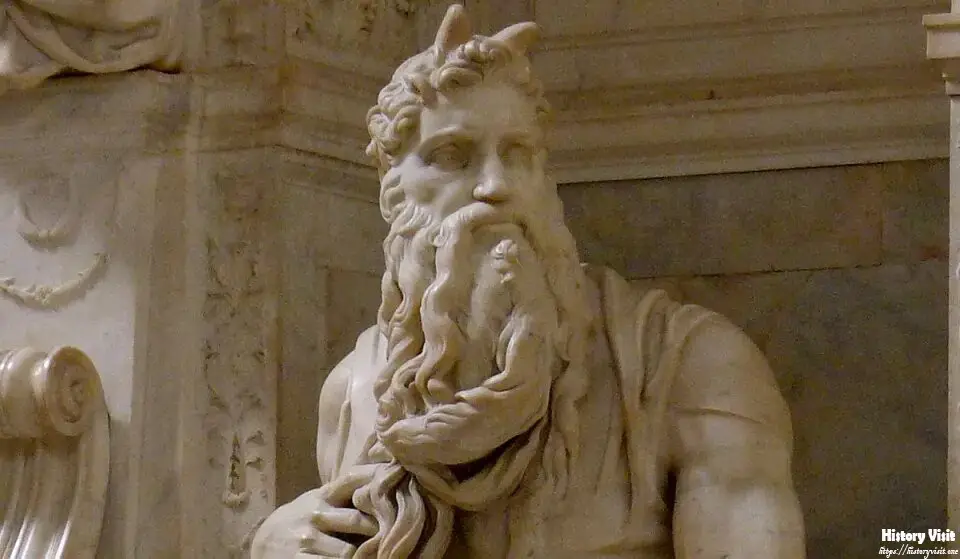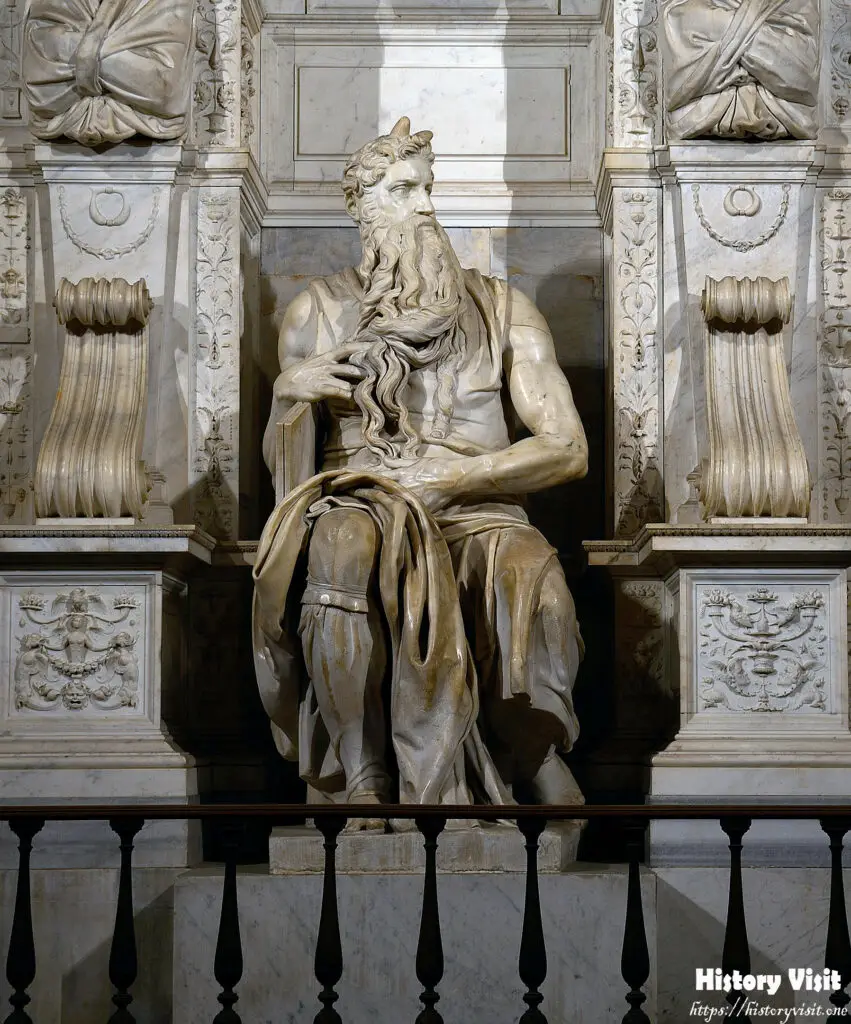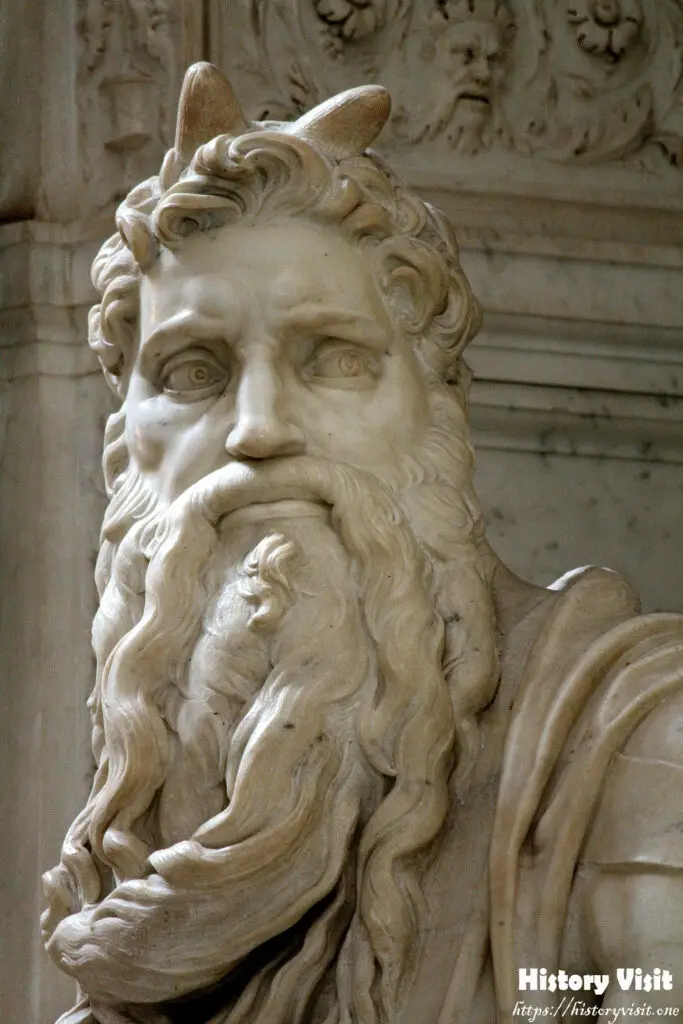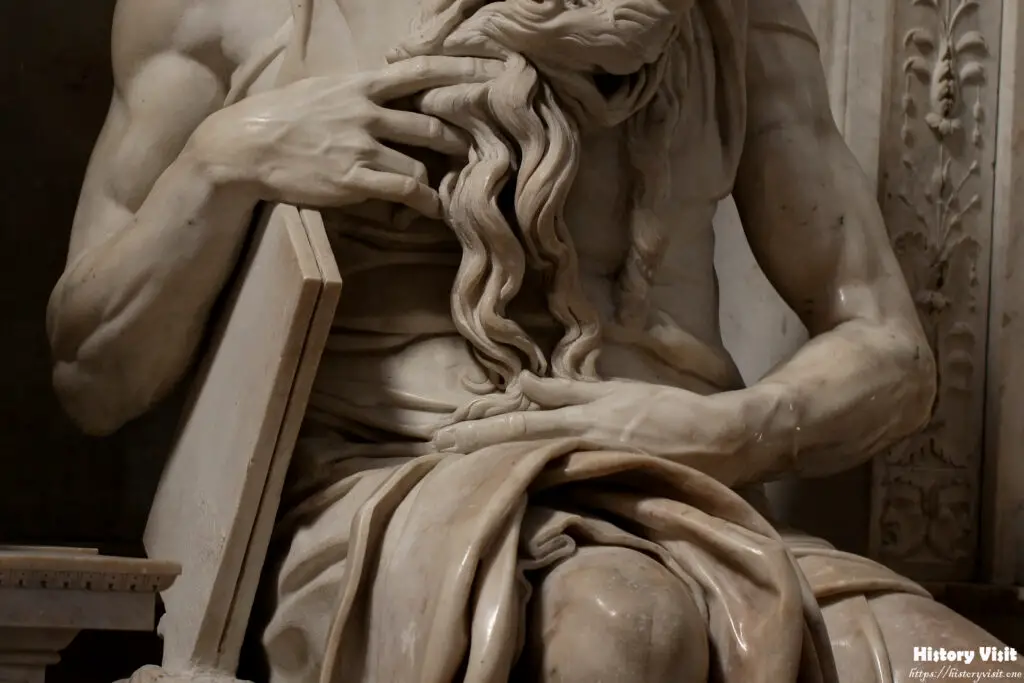Michelangelo’s Moses: A Masterpiece of Renaissance Sculpture

Introduction
In the hallowed halls of San Pietro in Vincoli, Rome, Italy, there resides a masterpiece that transcends mere stone and chisel—a testament to the boundless genius of one of history’s greatest artists. Michelangelo’s Moses, sculpted between 1513 and 1515, emerges from its marble cocoon as a towering figure of spiritual and artistic grandeur. Within the sacred confines of this ancient basilica, visitors are greeted by the solemn gaze of the Hebrew prophet, his countenance imbued with a sense of divine majesty and human frailty.
The genesis of Michelangelo’s Moses lies in the tumultuous political and religious landscape of Renaissance Italy—a period marked by ambition, intrigue, and the clash of competing artistic and intellectual currents. Commissioned as part of Pope Julius II’s grandiose tomb project, the sculpture was intended to serve as a centerpiece of monumental artistry, commemorating the pontiff’s illustrious reign and securing his place in the annals of history. Yet, in the hands of Michelangelo, the marble block transformed into more than a mere funerary monument; it became a transcendent symbol of artistic brilliance and spiritual contemplation.
As we embark on a journey to unravel the mysteries and marvels of Michelangelo’s Moses, we are invited to explore not only the intricacies of its craftsmanship and iconography but also the profound impact it has had on the course of art history and human consciousness. From its creation amidst the swirling currents of Renaissance culture to its enduring legacy as a cultural landmark, the sculpture continues to inspire awe and admiration among scholars, connoisseurs, and pilgrims alike. Join us as we delve into the heart of this timeless masterpiece, uncovering the secrets and symbolism that have captivated audiences for centuries.
Michelangelo Buonarroti: The Genius Behind the Sculpture

Michelangelo Buonarroti, often hailed as the quintessential Renaissance artist, left an indelible mark on the world of art with his unparalleled talent and vision. Born in 1475 in Caprese, Italy, Michelangelo displayed prodigious artistic abilities from a young age. Under the patronage of influential figures such as Lorenzo de’ Medici, he honed his craft and developed a distinctive style characterized by muscular dynamism and emotional intensity.
The commission of Moses came at a pivotal moment in Michelangelo’s career, marking his transition from the realm of sculpture to monumental architecture. Tasked with creating a grandiose tomb for Pope Julius II, Michelangelo envisioned Moses as one of the central figures within the ensemble. Drawing inspiration from biblical narratives and classical ideals, he embarked on the monumental task of sculpting a larger-than-life representation of the Hebrew prophet.
The Commission and Creation of Moses

The commission of Moses for Pope Julius II’s tomb project presented Michelangelo with both a creative challenge and an opportunity to showcase his artistic prowess. Amidst the tumultuous political and religious landscape of Renaissance Italy, Michelangelo embarked on the monumental task of bringing the biblical figure of Moses to life. Working tirelessly in his studio in Florence, he meticulously crafted the sculpture from a single block of Carrara marble, imbuing it with a sense of divine presence and human emotion.
Michelangelo’s process of creating Moses was marked by a profound sense of devotion and artistic experimentation. Drawing upon his extensive knowledge of anatomy and sculpture, he sculpted Moses with an unprecedented level of realism and expressiveness. The sculpture’s monumental scale and intricate detailing reflect Michelangelo’s mastery of form and composition, as well as his ability to convey profound psychological depth.
The completion of Moses in 1515 marked a triumphant moment in Michelangelo’s career, solidifying his reputation as one of the preeminent artists of the Renaissance. Installed within the ancient basilica of San Pietro in Vincoli, the sculpture continues to inspire awe and admiration among visitors from around the world. Its enduring legacy serves as a testament to Michelangelo’s genius and the enduring power of art to transcend time and space.
Iconography and Interpretation

Michelangelo’s Moses is rich with symbolic imagery and allegorical meaning, inviting viewers to contemplate its deeper theological and artistic significance. At the center of the composition stands Moses, his commanding figure exuding a sense of divine authority and spiritual power. Clad in flowing robes and adorned with a majestic beard, he gazes into the distance with a mixture of solemnity and resolve, his features etched with a profound sense of introspection.
The symbolism of Moses extends beyond mere representation, embodying themes of redemption, leadership, and the human struggle for faith and salvation. As the central figure of the Old Testament narrative, Moses serves as a bridge between the divine and the mortal realms, leading his people out of bondage and into the promised land. Michelangelo captures this sense of transcendent heroism in his portrayal of Moses, elevating him to the status of a mythic hero and spiritual guide.
Interpretations of Michelangelo’s Moses have varied widely over the centuries, reflecting the shifting cultural and religious attitudes of different epochs. For some, the sculpture represents a triumph of humanism and the celebration of the individual spirit. For others, it embodies the enduring struggle between faith and reason, tradition and innovation. Regardless of interpretation, however, one thing remains clear: Michelangelo’s Moses continues to captivate and inspire audiences with its timeless beauty and profound insight into the human condition.
Reception and Legacy

Upon its unveiling in the early 16th century, Michelangelo’s Moses elicited widespread acclaim and admiration from both patrons and the public alike. Scholars and connoisseurs praised its technical virtuosity and emotional resonance, hailing it as a masterpiece of Renaissance sculpture. Yet, despite its initial success, the sculpture faced criticism and controversy in subsequent centuries, as shifting artistic tastes and religious sensibilities cast doubt on its significance.
Nevertheless, Michelangelo’s Moses has endured the test of time, emerging as one of the most iconic works of art in Western history. Its influence can be seen in the countless interpretations and adaptations that have proliferated over the centuries, from paintings and prints to literature and film. Moreover, its legacy lives on in the countless artists and artisans who continue to draw inspiration from its sublime beauty and profound spiritual resonance.
As we reflect on the enduring legacy of Michelangelo’s Moses, we are reminded of the transformative power of art to transcend the boundaries of time and space. In an age marked by uncertainty and upheaval, the timeless beauty and profound insight of this masterpiece serve as a beacon of hope and inspiration for generations to come. Whether viewed as a religious icon, a cultural landmark, or simply a triumph of human creativity, Michelangelo’s Moses continues to remind us of the boundless potential of the human spirit to achieve greatness in the pursuit of truth and beauty.
Conclusion
In conclusion, Michelangelo’s Moses stands as a testament to the genius and vision of one of history’s greatest artists. From its humble origins as part of a grandiose tomb project to its current status as a cultural icon, the sculpture has captivated audiences with its timeless beauty and profound insight into the human condition. As we contemplate its enduring legacy, we are reminded of the transformative power of art to inspire, uplift, and unite humanity in the pursuit of truth and beauty.
The legacy of Michelangelo’s Moses extends far beyond the confines of its marble form, continuing to inspire artists, scholars, and audiences around the world. Its timeless beauty and profound insight into the human condition serve as a reminder of the enduring power of art to transcend the boundaries of time and space. As we gaze upon the majestic figure of Moses, we are reminded of the boundless potential of the human spirit to achieve greatness in the pursuit of truth, beauty, and spiritual enlightenment.
As we journey through the annals of art history, Michelangelo’s Moses remains a beacon of hope and inspiration for generations to come. Its monumental scale, exquisite craftsmanship, and profound spiritual resonance continue to captivate and inspire audiences with its timeless message of faith, redemption, and the triumph of the human spirit. Truly, Michelangelo’s Moses stands as a testament to the enduring power of art to transform, uplift, and unite humanity in the pursuit of truth and beauty.



I was pretty pleased to find this site. I need to to thank you for your time due too this fantastic read!!
I definitely really liked every little bit off
it and i also have you book-marked too chesck out
new things on your website.